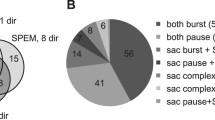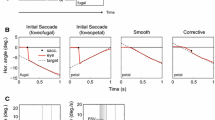Summary
The oculomotor performance of monkeys was investigated before and after destruction of nigrostriatal dopamine neurons by MPTP (1-methyl-4-phenyl-1, 2, 3, 6-tetrahydropyridine). Stimulus-triggered saccades and their relationships to arm movements were measured in a reaction time task. Spontaneous eye movements were recorded while monkeys sat in a primate chair and looked around the laboratory without performing any task. In the reaction time task, saccades and arm movements were commonly triggered by the rapid, visible and audible opening of a small food-containing box which was located at a constant position in front of the animal at eye level. Median saccadic latencies ranged from 68 to 118 ms in intact animals. Saccades were followed by onset of electromyographic (EMG) activity in the extensor digitorum communis and the biceps brachii, the prime mover muscles for the following arm reaching movement. Latencies of stimulus-triggered saccades showed an absence of linear relationship to EMG or arm movement reaction time in intact animals (correlation coefficients of 0.15–0.56). This suggests that eye and arm movements were initiated independently from each other in this experimental situation. Treatment with MPTP resulted in 98–99.5% loss of striatal dopamine in both monkeys. This induced a 29–93% increase in saccadic latency in the reaction time task. The sequential occurrence of saccade, EMG activity and arm movement in each trial was preserved, although intervals between onset of saccades and onsets of EMGs and arm movements were prolonged by 53–173% and 33–679% respectively. Onsets of individual saccades remained uncorrelated with onsets of EMG activity or arm movement. Spontaneous eye movements were strongly reduced in frequency and amplitude after MPTP. Administration of the dopamine precursor L-Dopa increased spontaneous eye movements for less than two hours. The severe deficits in stimulus-triggered and spontaneous saccadic eye movements are oculomotor components of hypokinesia arising after MPTP-induced lesions of the nigrostriatal dopamine system in primates. The data are further evidence for a role of midbrain dopamine neurons in behavioral responsiveness and spontaneous activity.
Similar content being viewed by others
References
Apicella P, Legallet E, Nieoullon A, Trouche E (1986) Differential time-course of reaction time recovery depending on variations in the amplitude of a goal-directed movement after nigrostriatal lesion in monkeys. Neurosci Lett 68: 79–84
Albano JE, Mishkin M, Westbrook LE, Wurtz RH (1982) Visuomotor deficits following ablation of monkey superior colliculus. J Neurophysiol 48: 338–351
Bernstein IH, Chu PK, Briggs P (1973) Stimulus intensity and foreperiod effects in intersensory facilitation. Q J Exp Psychol 25: 171–181
Biguer B, Jeannerod M, Prablanc C (1982) The coordination of eye, head, and arm movements during reaching to a single visual target. Exp Brain Res 46: 301–304
Boch R, Fischer B, Ramsperger, E (1984) Express-saccades of the monkey: reaction times versus intensity, size, duration, and eccentricity of their targets. Exp Brain Res 55: 223–231
Bronstein AM, Kennard C (1985) Predictive ocular motor control in Parkinson's disease. Brain 108: 925–940
Brooks BA, Fuchs AF, Finocchio D (1986) Saccadic eye movement deficits in the MPTP monkey model of Parkinson's disease. Brain Res 383: 402–407
Brozoski TJ, Brown RM, Rosvold HE, Goldman PS (1979) Cognitive deficit caused by regional depletion of dopamine in prefrontal cortex of rhesus monkey. Science 205: 929–932
Bruce CJ, Goldberg ME (1985) Primate frontal eye fields. I. Single neurons discharging before saccades. J Neurophysiol 53: 603–635
Burns RS, Chiueh CC, Markey SP, Ebert MH, Jacobowitz DM, Kopin IJ (1983) A primate model of parkinsonism: selective destruction of dopaminergic neurons in the pars compacta of the substantia nigra by N-methyl-4-phenyl-1,2,3,6-tetrahydropyridine. Proc Natl Acad Sci 80: 4546–4550
Cogan DC (1974) Paralysis of down-gaze. Arch Ophthalmol 91: 192–199
Corin MS, Elizan TS, Bender MB (1972) Oculomotor function in patients with Parkinson's disease. J Neurol Sci 15: 251–265
Crossman AR, Sambrook MA (1978) Experimental torticollis in the monkey produced by unilateral 6-hydroxydopamine brain lesions. Brain Res 149: 498–502
DeJong JD, Melvill Jones G (1971) Akinesia, hypokinesia, and bradykinesia in the oculomotor system of patients with Parkinson's disease. Exp Neurol 32: 58–68
Duverger C, Barré JA (1921) Troubles des mouvements associés des yeux chez les tabetiques, les parkinsoniens, dans l'encéphalite épidémique et chez les labyrinthiques: essai pathologique. Rev Neurol 37: 439–454
Fischer, B (1987) The preparation of visually guided saccades. Rev Physiol Biochem Pharmacol 106: 1–35
Fischer B, Boch R (1983) Saccadic eye movements after extremely short reaction times in the monkey. Brain Res 260: 21–26
Fischer B, Rogal L (1986) Eye-hand coordination in man: a reaction time study. Biol Cybern 55: 253–261
Fuchs AF (1967) Saccadic and smooth pursuit eye movements in the monkey. J Physiol 191: 609–631
Ghez C, Vicario D (1978) The control of rapid limb movement in the cat. I. Response latency. Exp Brain Res 33: 173–189
Herman R, Herman R, Maulucci R (1981) Visually triggered eye-arm movements in man. Exp Brain Res 42: 392–398
Hikosaka O, Sakamoto M (1986) Cell activity in monkey caudate nucleus preceding saccadic eye movements. Exp Brain Res 63: 659–662
Hikosaka O, Wurtz RH (1983) Visual and oculomotor functions of monkey substantia nigra pars reticulata. I. Relation of visual and auditory responses to saccades. J Neurophysiol 49: 1230–1253
Hikosaka O, Wurtz RH (1985) Modification of saccadic eye movements by GABA-related substances. I. Effect of muscimol and bicuculline in monkey superior colliculus. J Neurophysiol 53: 266–291
Hopkins DA, Niessen LW (1976) Substantia nigra projections to the reticular formation, superior colliculus and central gray in the rat, cat and monkey. Neurosci Lett 2: 253–259
Jonsson G, Hallman H, Mefford I, Adams RN (1980) The use of liquid chromatography with electrochemical detection for the determination of adrenaline and other biogenic amines in the CNS. In: Fuxe K, Goldstein M, Hökfelt B, Hökfelt T (eds) Central adrenaline neurons. Pergamon Press, Oxford New York, pp 59–71
Luschei E, Saslow C, Glickstein M (1967) Muscle potentials in reaction time. Exp Neurol 18: 429–442
Mettler FA, Mettler CC (1942) The effect of striatal injury. Brain 65: 242–255
Miles FA, Kawano K, Optican LM (1986) Short-latency following responses of monkey. I. Dependence on temporospatial properties of visual input. J Neurophysiol 56: 1321–1354
Poirier LJ (1960) Experimental and histological study of midbrain dyskinesias. J Neurophysiol 23: 534–551
Porrino LJ, Goldman-Rakic PS (1982) Brainstem innervation of prefrontal and anterior cingulate cortex in the rhesus monkey revealed by retrograde transport of HRP. J Comp Neurol 205: 63–76
Raab DH (1962) Statistical facilitation of simple reaction times. Trans NY Acad Sci 24: 574–590
Rogal L, Reible G, Fischer B (1985) Reaction times of the eye and the hand of the monkey in a visual reach task. Neurosci Lett 58: 127–132
Ruffieux A, Schultz W (1980) Dopaminergic activation of reticulata neurones in the substantia nigra. Nature 285: 240–241
Schiller PH, Koerner F (1971) Discharge characteristics of single units in superior colliculus of the alert rhesus monkey. J Neurophysiol 34: 920–936
Schiller PH, Sandell JH, Maunsell JHR (1987) The effect of frontal eye field and superior colliculus lesions on saccadic latencies in the rhesus monkey. J Neurophysiol 57: 1033–1049
Schiller PH, True SD, Conway JL (1980) Deficits in eye movements following frontal eye-field and superior colliculus ablations. J Neurophysiol 44: 1175–1189
Schultz W (1982) Depletion of dopamine in the striatum as experimental model of parkinsonism: direct effects and adaptive mechanisms. Prog Neurobiol 18: 121–166
Schultz W (1986) Responses of midbrain dopamine neurons to behavioral trigger stimuli in the monkey. J Neurophysiol 56: 1439–1462
Schultz W, Studer A, Jonsson G, Sundström E, Mefford I (1985) Deficits in behavioral initiation and execution processes in monkeys with 1-methyl-4-phenyl-1,2,3,6-tetrahydropyridine induced parkinsonism. Neurosci Lett 59: 225–232
Schultz W, Studer A, Romo R, Sundstrom E, Jonsson G, Scarnati E (1989) Deficits in reaction times and movement times as correlates of hypokinesia in monkeys with MPTP-induced striatal dopamine depletion. J Neurophysiol 61: 651–668
Shibasaki H, Tsuji S, Kuroiwa Y (1979) Oculomotor abnormalities in Parkinson's disease. Arch Neurol 36: 360–364
Spidalieri G, Busby L, Lamarre Y (1983) Fast ballistic arm movements triggered by visual, auditory, and somesthetic stimuli in the monkey. II. Effects of unilateral dentate lesion on discharge activity of precentral cortical neurons and reaction time. J Neurophysiol 50: 1359–1379
Teräväinen H, Calne DB (1980) Studies of parkinsonian movement. 2. Initiation of fast voluntary eye movement during postural disturbance. Acta Neurol Scand 62: 149–157
Ungerstedt U (1971) Adipsia and aphagia after 6-hydroxydopamine induced degeneration of the nigro-striatal dopamine system. Acta Physiol Scand Suppl 367: 95–117
Viallet F, Trouche E, Beaubaton D, Nieoullon A, Legallet E (1983) Motor impairment after unilateral electrolytic lesions of the substantia nigra in baboons: behavioral data with quantitative and kinematic analysis of a pointing movement. Brain Res 279: 193–206
Warabi T. Noda H, Yanagisawa N, Tashiro K, Shindo R (1986) Changes in sensorimotor function associated with the degree of bradykinesia of Parkinson's disease. Brain 109: 1209–1224
Wurtz RH, Goldberg ME (1971) Superior colliculus cell responses related to eye movements in awake monkeys. Science 171: 82–84
Wurtz RH, Goldberg ME (1972) Activity of superior colliculus in behaving monkey. IV. Effects of lesions on eye movements. J Neurophysiol 35: 587–596
Author information
Authors and Affiliations
Rights and permissions
About this article
Cite this article
Schultz, W., Romo, R., Scarnati, E. et al. Saccadic reaction times, eye-arm coordination and spontaneous eye movements in normal and MPTP- treated monkeys. Exp Brain Res 78, 253–267 (1989). https://doi.org/10.1007/BF00228897
Received:
Accepted:
Issue Date:
DOI: https://doi.org/10.1007/BF00228897




